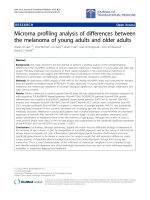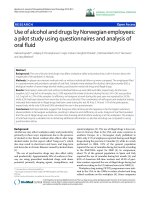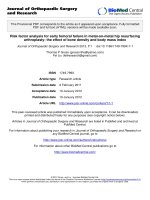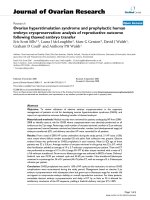Báo cáo hóa học: " Editorial Time-Frequency Analysis and Its Applications to Multimedia Signals" pptx
Bạn đang xem bản rút gọn của tài liệu. Xem và tải ngay bản đầy đủ của tài liệu tại đây (434.84 KB, 3 trang )
Hindawi Publishing Corporation
EURASIP Journal on Advances in Signal Pr ocessing
Volume 2010, Article ID 739017, 3 pages
doi:10.1155/2010/739017
Editorial
Time-Frequency Analysis and Its Applications to
Multimedia Signals
Srdjan Stankovi
´
c,
1
Sridhar Krishnan,
2
Bijan Mobasseri,
3
and Yimin Zhang
3
1
University o f Montenegro, Faculty o f Electrical Engineering, Dzordza Vasingtona bb, 20000 Podgorica, Montenegro
2
Department of Electrical and Computer Engineer ing, Ryerson University, Toronto, ON, Canada
3
Center for Advanced Communications, Villanova University, Villanova, PA 19085, USA
Correspondence should be addressed to Srdjan Stankovi
´
c,
Received 31 December 2010; Accepted 31 December 2010
Copyright © 2010 Srdjan Stankovi
´
c et al. This is an open access article distributed under the Creative Commons Attribution
License, which permits unrestricted use, distribution, and reproduction in any medium, provided the original work is properly
cited.
Time-frequency analysis has been intensively investigated
and developed in the last two decades. A variety of time-
frequency distributions have been developed to provide
efficient analysis of signals with a time-varying spectral
content. In most cases, signal analyses in the joint time-
frequency domain outperform the traditional frequency-
domain approaches. Generally, the time-frequency distribu-
tions have found fruitful applications in many important
fields dealing with nonstationary signals, such as biomed-
ical, radar, seismic, telecommunications, and mechanical
engineering. Additionally, a large number of applications
are related to multimedia signals in speech, audio/music,
image, and video signal processing, where time-frequency
analysis can be employed to broaden and enhance the signal
processing capabilities. Because each type of multimedia
signals has its specific nature that may significantly differ
from others, the applicability and method of time-frequency
analysis depend on the multimedia d ata to be processed. This
fact opens a number of challenging directions for research
in the field of time-frequency analysis and its applications to
multimedia signals. For instance, having the different dimen-
sionalities of multimedia signals in mind, time-frequency
analysis for one-, two-, and three-dimensional signals should
be used.
Since there is no single time-frequency distribution that
can be used for efficient representations of all kinds of
nonstationary signals, novel theoretical formulations that
may lead to more practical solutions are still challenging.
Mor eover, improved forms o f time-frequency distributions
allow us to further expand and diversify their applicability.
This special issue aims to help readers to understand how
time-frequency distributions could be used for the analysis
of multimedia signals, with emphasis on their specific
nature, complexity, and multidimensionality. Toward this
end, various specific distributions have been examined and
highlighted in terms of their appropriateness for different
multimedia applications.
A set of two review papers and eight research articles are
collected in this special issue.
At the beginning, the review paper “Time-frequency
analysis and its application in digital watermarking,”by
S. Stankovi
´
c, provides a detailed theoretical overv iew of
various time-frequency distributions, discussing their main
advantages and drawbacks when applied to multimedia
signals. The goal is to facilitate the choice of an appropriate
distribution in a specific multimedia application. The second
part of this paper is dedicated to time-frequency-based
digital watermarking and its application to digital audio,
image, and v ideo signals. Here, the main focus is on the
unified concept of using time-frequency approaches to shape
the watermarks according to the host si gnal components.
The watermark is embedded as well as detected in the time-
frequency domain.
The second review paper, “Audio signal pr ocessing us ing
time-frequency approaches: coding, classification, fingerprint-
ing, and watermarking” by K. Umapathy et al., discusses
different applications of time-frequency analysis in audio
signal processing. Currently, a great number of audio
processing applications r equire s ophisticated algorithms for
compression, classification, and digital audio protection.
2 EURASIP Journal on Advances in Signal Processing
Hence, this review paper presents several time-frequency-
based techniques that has been used to provide efficient
extraction of information from audio signals for the purpose
of audio coding, music classification, classification of envi-
ronmental sounds, audio fingerprinting, and watermarking.
It is important to emphasize that the universal time-
frequency approach provides modeling of audio signals
in the joint time-frequency domain, which further allows
one to process model parameters based on the application
requirements.
The eight research articles can be roughly categorized
into two general areas: (1) robust and fragile digital data pro-
tection algorithms and (2) time-frequency-based algorithms
for data analysis, classification, and compression.
In the first four papers, different time-frequency-based
watermarking procedures for multimedia data protection
have been proposed. Generally, it has been shown that time-
frequency analyses and representations can provide very
flexible algorithms that are capable of retaining the high
fidelity of multimedia signals while achieving secure data
protection.
The paper “A robust image watermarking in the joint
time-frequency domain,”byM.
¨
Ozt
¨
urk et al., proposes
a robust, secure, and high-capacity image watermarking
procedure based on spatiofrequency representation. The
suitable representation is obtained using the discrete evolu-
tionary transform (DET) calculated by the Gabor expansion.
By combining the advantages of the spatial and spectral
domains, the proposed procedure provides robustness to
commonly used attacks.
In order to characterize the time-varying spectral con-
tent of speech signals, the S-method-based time-frequency
analysis has been considered in the paper entitled “Time-
frequency-based speech regions characterization and eigenvalue
decomposition applied to speech watermarking”byI.Orovi
´
c
and S. Stankovi
´
c. The eigenvalues decomposition is applied
to the representation obtained by the S-method to separate
speech components. Different components can be combined
to create an arbitrary time-frequency mask that is used
to shape the time-frequency characteristics o f watermark.
Both watermark embedding and detection are performed in
the time-frequency domain. This procedure provides great
flexibility in implementation and is characterised by reliable
detection results.
An approach for the optimization of digital audio
watermarking based on the genetic algorithm is pre-
sented in the paper “A genetic algorithm o ptimization
technique for multiwavelet-based digital audio watermark-
ing” by P. Kumsawat. The watermark is embedded in the
discrete multiwavelet transform domain using the quan-
tization index modulation technique. The genetic algo-
rithm provides four optimal watermarking parameters, thus
improving both the audio signal quality and watermark
robustness.
The fragile watermarking methods for image authen-
tication have been proposed in the paper “Time-frequency
and time-scale-based fragile watermarking methods for
image authentication” by B. Barkat and F. Sattar. The
first method is based on the time-fr equency analysis
and uses the nonstationary watermark with known time-
frequency characteristics. The time-frequency signature of
the extracted watermark is used to identify whether the
image content has been modified. The second fragile
watermarking approach is based on the hierarchical image
decomposition using wavelet analysis. The special features of
watermark, created as a complex chirp signal, ar e used for
content authentication.
The remaining four papers are related to different time-
frequency-based algor ithms for efficient multimedia data
representation, classification, and compression.
In order to obtain high-resolution reassigned time-
frequency representations, the use of fuzzy clustering
for Bayesian regularized neural network model has been
explored in “Validity-guided fuzzy clustering evaluation for
neural network-based time-frequency reassignment”byI.Shafi
et al. The resulting time-frequency distributions provide
high resolution and do not contain interference terms
between different signal components. This approach can
provide good discrimination between known patterns for
nonstationary signal classification, even when signals are
corrupted with additive Gaussian noise with a small variance.
The paper “Parametric time-frequency analysis and its
applications in music classification,” by Y. Shen et al., deals
with analysis and classification of music signals. Music
signals are decomposed into atoms using an adaptive time-
frequency-based matching pursuit method with Gabor dic-
tionary. The discriminant classification features are obtained
by analyzing the atoms parameters. It has been shown that
the proposed method provides good classification accuracy.
T ime-frequency analysis and the Hermite p rojection
method have been combined in the paper “Video frames
reconstruction based on time-frequency analysis and Hermite
projection method”byS.Stankovi
´
c et al. to provide a method
for temporal analysis a nd reconstruction of digital video
sequences. The S -method is used to examine t he station-
arity/nonstationarity of the video coefficients. The recon-
struction of stationary coefficients is done using the first
coefficient in the temporal sequence, while the nonstationary
coefficients are reconstructed using the Hermite projection
method. The proposed method can be combined with the
existing video compression algorithms to further reduce the
volume of data for high-quality video reconstruction.
The paper “Fuzzy morphological polynomial image rep-
resentation” by C P. Huang et al. combines the advantages
of optimum fuzzy fitting and morphological operators to
extract geometric information from signals. The geometrical
decomposition is achieved by windowing and sequentially
applying fuzzy morphological opening with structuring
functions. The resulting representation can be used in data
compression and fractal dimension estimation of temporal
signals and images.
Acknowledgments
We would like to thank all the authors for their contributions
to this special issue. We would also like to thank the
reviewers for their great help in papers selection, as well as
to the technical st aff of Hindawi Publishing Corporation.
EURASIP Journal on Advances in Sig nal Processing 3
Finally we are very thankful to the Editor Phillip Regalia for
his support of this special issue.
Srdjan Stankovi´c
Sridhar Krishnan
Bijan Mobasseri
Yimin Zhang









